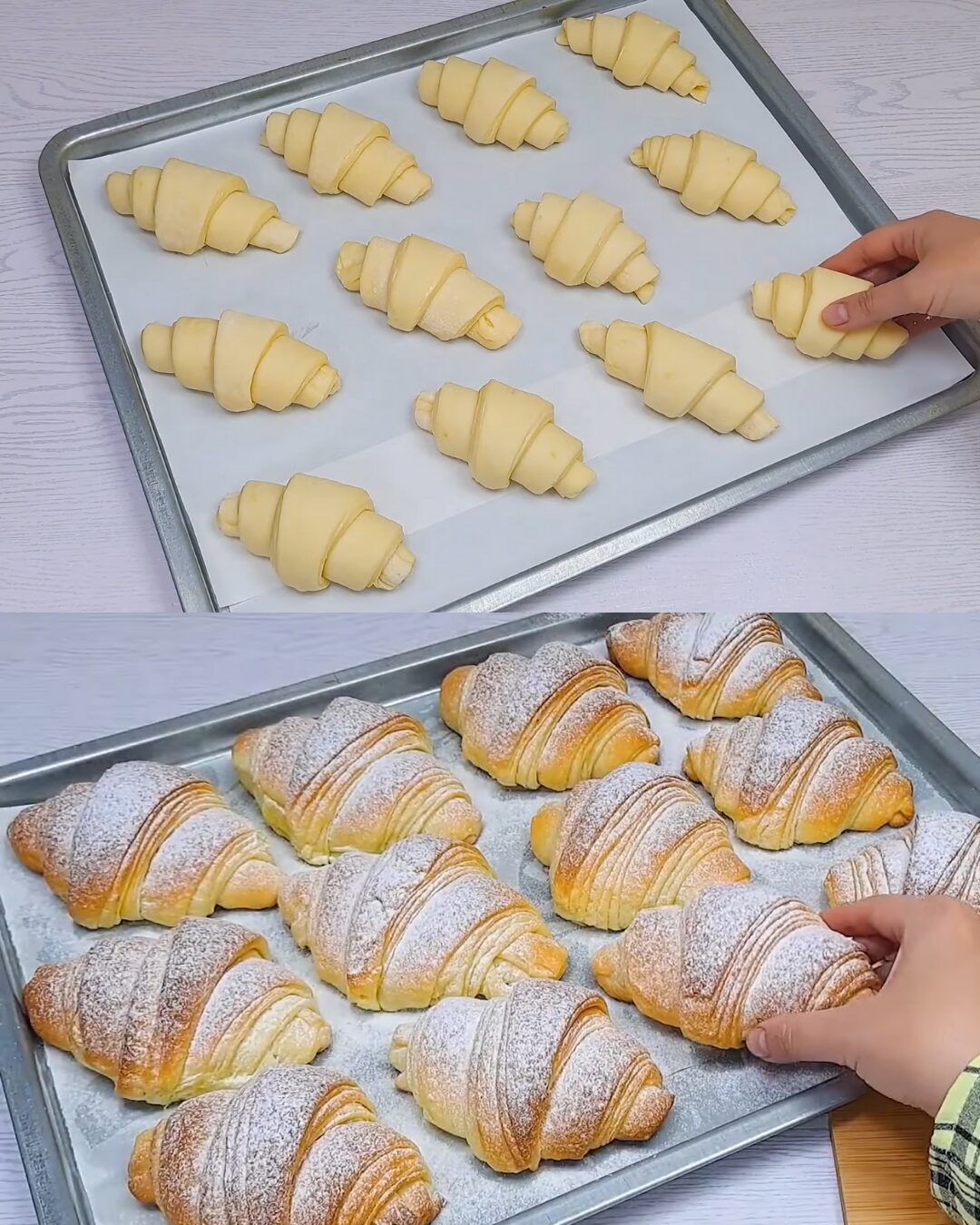Soft, pillowy, and delicately sweet, these Fluffy Vanilla-Lemon Sweet Buns are the kind of bake that fills your kitchen with the warm scent of nostalgia. Perfect for breakfast, brunch, or an afternoon treat, these enriched yeast buns are layered with butter, kissed with lemon zest, and lightly sweetened with sugar and vanilla. Once baked to golden perfection, they’re finished with a dusting of powdered sugar that gives them a bakery-worthy look and irresistible taste. Whether you serve them with coffee or warm milk, they’re sure to bring smiles and comfort with every bite.
Cooking Time
Preparation: 30 minutes
First rise: 15 minutes
Second rise: 20 minutes
Final proofing: 45 minutes
Baking: 15–20 minutes
Total time: 2 hours 15 minutes
Yield: 16 sweet buns
Ingredients
Dough
600 g wheat flour (preferably all-purpose or bread flour)
40 g sugar
320 ml warm milk (around 37°C/98.6°F)
10 g dried yeast (or 25 g fresh yeast)
50 g plain yogurt
2 egg yolks
60 g sugar
5 g salt
10 g vanilla sugar (or 1 tsp vanilla extract)
Zest of 1 lemon
100 g softened butter
Lamination & Shaping
100 g soft butter (for layering)
Extra flour for dusting
Finishing
Melted butter for brushing
Powdered sugar for dusting
Step-by-Step Cooking Directions
1 Prepare the Flour Base
Sift 600 g of flour into a large bowl to aerate it. Make a well in the center.
2 Activate the Yeast
In the well, add 40 g sugar and pour in 320 ml of warm milk. Sprinkle 10 g dried yeast on top and stir gently. Let it sit for about 15 minutes, or until foamy and bubbly.
3 Enrich the Dough
Add 50 g yogurt, 2 egg yolks, 60 g additional sugar, 5 g salt, 10 g vanilla sugar (or 1 tsp vanilla extract), and the zest of one lemon. Stir to combine all ingredients into a thick batter.
4 Begin Kneading
Use a spatula or dough whisk to begin kneading the dough. When it starts to come together, gradually add 100 g of softened butter, kneading it in until fully absorbed.
5 First Gluten Rest
Cover the bowl and let the dough rest for 20 minutes at room temperature to allow the gluten to begin developing. This makes the dough easier to work with.
6 Knead the Dough by Hand
Dust a work surface lightly with flour. Transfer the dough and knead it with your hands for several minutes until it becomes soft, elastic, and slightly glossy.
7 Bulk Fermentation
Place the dough into a clean, lightly oiled bowl. Cover and allow it to rise in a warm place for 45 minutes, or until doubled in size.
8 Divide and Shape
Turn the dough out onto a floured surface and divide it into 6 equal portions. Roll each portion into a smooth ball.
9 Flatten and Butter
Using a rolling pin, roll out each ball into a flat disc. Brush generously with softened butter. Stack the discs on top of each other, buttering between each layer.
10 Rest Again
Cover the stacked dough and let rest for 20 minutes on the work surface. This softens the butter and relaxes the dough for easier rolling.
11 Roll and Cut
Sprinkle the table with flour and roll the layered stack into a large thin rectangle. Use a knife or pizza cutter to divide it into 16 triangle or rectangular pieces.
12 Shape the Buns
Take each piece and roll it tightly, starting from the wider side if triangular, into small swirled buns.
13 Final Proofing
Place the shaped buns on a parchment-lined baking tray. Cover loosely and let rise for 45 minutes, or until puffy and noticeably larger.
14 Preheat & Bake
Preheat your oven to 180°C (356°F). Brush the tops of the buns with melted butter, then bake for 15–20 minutes, or until golden brown and aromatic.
15 Garnish & Serve
Allow buns to cool slightly, then dust with powdered sugar. Serve warm for the softest texture and freshest flavor.
Nutritional Information (per bun, approximate)
Calories: 220 Fat: 9 g Carbohydrates: 30 g Protein: 4 g Sugar: 9 g Sodium: 120 mg
The Origins and Popularity of the Recipe
These sweet buns are reminiscent of Eastern European and Central European yeasted pastries, such as Polish drożdżówki, Romanian cornulețe, and Hungarian kalács. Their layered buttery texture echoes laminated breads like brioche or Danish pastries, but they’re simpler and more home-baker friendly. With a blend of yogurt, lemon, and vanilla, they’ve become a staple on social platforms and baking blogs, popular for their elegant look and soft bite.
Reasons Why You’ll Love the Recipe
-
Incredibly soft and fluffy with a golden top and buttery interior
-
Subtle vanilla-lemon aroma makes every bite fragrant and special
-
Not too sweet, making them suitable for breakfast or dessert
-
Freezer-friendly – perfect for make-ahead batches
-
Versatile dough that adapts to other fillings like jam, chocolate, or nuts
Health Benefits
Though a treat, these buns contain:
-
Yogurt, which provides beneficial probiotics and calcium
-
Egg yolks, offering vitamin D, choline, and good fats
-
Lemon zest, which contains antioxidant-rich essential oils
Use organic ingredients where possible for better nutrition.
Serving Suggestions
-
Enjoy warm with butter and honey for breakfast
-
Pair with a cappuccino or black tea for a European-style coffee break
-
Serve with fruit preserves for a light brunch offering
-
Add whipped cream and berries for a quick dessert
Common Mistakes to Avoid
-
Overheating the milk—kills the yeast. Keep milk under 40°C (104°F).
-
Under-kneading—results in dense buns. Knead until elastic and smooth.
-
Skipping proofing—yields tight, doughy buns. Allow full rise for fluffiness.
-
Not brushing butter between layers—reduces lamination. Use all 100 g for layering.
Pairing Recommendations
-
Drinks: Hot cocoa, Earl Grey tea, or a latte
-
Fruit sides: Fresh berries, orange slices, or a fruit compote
-
Spreads: Apricot jam, clotted cream, or lemon curd
-
Savory: Try alongside a salty cheese plate to balance sweetness
Cooking Tips
-
Use room-temp ingredients for better yeast performance
-
Don’t rush the rise—wait until dough doubles for best texture
-
Roll dough evenly so buns bake at the same speed
-
Brush melted butter post-bake for extra softness and sheen
Similar Recipes to Try
-
Soft Honey Butter Dinner Rolls
-
Russian Rose Bread with Cinnamon
-
Milk Bread Rolls (Japanese-style)
-
Vanilla Custard-Filled Buns
-
Lemon Poppy Seed Brioche
Variations to Try
-
Filled Buns: Add jam, chocolate chips, or sweetened cream cheese inside each roll
-
Cinnamon version: Sprinkle dough layers with cinnamon sugar before rolling
-
Nut version: Add ground walnuts or hazelnuts for a hearty crunch
-
Glaze finish: Top cooled buns with vanilla or lemon icing
-
Savory twist: Skip the sugar and fill with cheese and herbs
Ingredient Spotlight – Yeast
Yeast is the magic leavening agent behind the buns’ airy crumb. This recipe uses active dry yeast, which requires proofing in warm liquid. Be sure it’s fresh—check the expiration date and store in a cool, dry place. Yeast feeds on sugar, producing carbon dioxide and alcohol, which give the buns their rise and flavor.
Conclusion
These Fluffy Vanilla-Lemon Sweet Buns are a celebration of comfort, craftsmanship, and the joy of homemade baking. From the golden crust to the buttery, fragrant center, each bun invites warmth and contentment. Whether you’re baking for a family breakfast, festive gathering, or simply to enjoy with your coffee, this recipe is bound to become a treasured favorite in your home.
Frequently Asked Questions
1 Can I use instant yeast instead of dried active yeast?
Yes, you can use the same amount of instant yeast. Skip the activation step and mix it directly with the flour.
2 Can I make the dough in advance?
Yes. After the first rise, refrigerate the dough overnight. Let it come to room temperature before shaping and proofing.
3 Can I freeze the baked buns?
Absolutely. Let them cool completely, then freeze in an airtight bag. Reheat in the oven at 160°C for 5–7 minutes.
4 Can I use whole wheat flour instead?
You can replace up to 50% of the flour with whole wheat. Expect denser buns with a nuttier flavor.
Advertisement
5 Can I make it egg-free?
Yes, replace each yolk with 1 Tbsp of plant-based yogurt or milk for a similar texture, though flavor may differ slightly.
6 Can I substitute the yogurt?
Sour cream or buttermilk work as excellent substitutes. Greek yogurt is also fine.
7 What if my dough doesn’t rise?
Check the yeast—expired or overheated milk can prevent rising. Your kitchen may also be too cool; move to a warmer spot.
8 Can I add raisins or chocolate chips?
Definitely! Add about ½ cup of raisins, chips, or dried cranberries to the dough after kneading.
9 How do I know when they’re fully baked?
They should be deeply golden on top and sound hollow when tapped on the bottom.
10 Why is the crust a little crispy?
That’s from the butter brushed before baking—enjoy the contrast with the fluffy center! If you prefer an entirely soft crust, brush again after baking and cover briefly with a clean towel.

